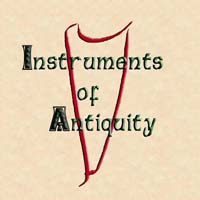
create for you?
(Links lead to detailed pages with larger photos and more information...)
Authentic:
Citole:
Cantigas style
Warwick style
Drums:
Bodhran
Gusli
Harps:
Bardic/Lap Harps:
Gut Strung
Celtic Wire Strung
Floor Harps:
Gothic
(more to come)
Kantele:
5 string
5 string Piccolo
9 string
Performance set
Lyres:
Trossingen
Sutton Hoo
Mosning Thorpe
Bergh Apton
Oberflacht
Cologne
Student Model
Bowed Lyres:
Crwth
Jouhikko
Psaltries:
Pig Nose
Cantigas style
Rebecs:
Soprano
Alto
Tenor
Bass
Zithers:
Fretted:
Epignette
Scheitholt
Fretless:
Myrna Hammered Dulcimer
Echoic:
Non-authentic,
but imitative of
the sound of the original instrument
Flutes
Whistles
Bass
Rebec
 Rebec Family:
Rebec Family:Bowed string instruments, the family to which Violins, Violas, Cellos and Basses belong, originated in the Middle East thousands of years ago. These instruments were usually constructed with hollow gourd bodies, skin soundboards, spike necks, and only a couple of strings. They were built in all shapes and sizes, and were a mainstay of the Middle Eastern musical tradition, along with frame drums, for millenia,
During the early Crusades, when much art and technology was brought back to Europe from the Saracen lands, a small gourd spike fiddle called a rabab which had become popular with the crusading warriors made it's way back to Europe. The primitive but effective construction method of using gourds and skins had no corrolary in the building traditions of western European instrument builders, so they took the concept of the rabab and created a similar instrument using a more familiar wood building technique, and ended up with an instrument we now know as a rebec. The rebec was built in many sizes, and was played individually as a fiddle or in consort with the other sizes in a manner similar to orchestral string quartets. This instrument was the practical but not direct ancestor of the violin, which because of superior tonal qualities and expression, superseded the rebec in all but the most rural areas shortly after it's introduction. But for more than 400 years, the unique, thin, nasal sound of the rebec was recognized as 'the' sound of bowed string instruments by most of Europe.
The rebec developed at the end into a very specialized instrument called a concertmaster's "kit", it was a small fiddle capable of being carried in a cloak pocket and pulled out to give needed demonstrations to orchestra members. In this role the rebec maintained some popularity until the middle 1800s.
Our rebecs are built with flat, unbraced and uncarved soundboards, a single piece hollowed body, flat pegheads or simple scrolls, and strung with either modern violin strings or gut. We can build with a flat fingerboard and bridge, a slightly curved fingerboard and bridge, or a fully curved fingerboard and bridge (all were options during the lifespan of the rebec). We can build with 2 or 3 strings for the smaller rebecs, and 2, 3, or 4 strings on the larger. Many options such as regionally influenced body shapes, custom rosettes, scroll caps, wood choices and scale lengths are available to the customer, just contact us to discuss your desires and we can familiarize you compl;etely with the options available to make it real.
Soprano Rebec (highest pitched in the rebec family, like a Violin in the viol family)
Alto Rebec (second highest pitched in the rebec family, like a Viola in the viol family)
Tenor Rebec (second lowest pitched in the rebec family, like a cello in the viol family)
Bass Rebec (lowest pitched in the rebec family, like a bass in the viol family). Pictured on this page.
For
more information or to place an order, contact:
Chris Nogy,
founder and craftsmancontact@instrumentsofantiquity.com
Phone: 479-283-6364
Please call between 9 AM and 7 PM U.S. Central Time (-6 GMT)
copyright (c) 2011